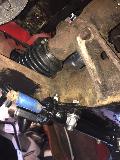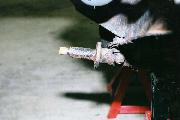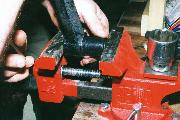The MGA With An Attitude
FRONT SUSPENSION REBUILD -- FS-202D
FS-202A - Disassembly
FS-202B - Inspection
FS-202C - Swivel Links and Bushings
FS-202D - A-arm Bushings (you are here)
FS-202E - Reassembly
A-arm Bushings
Rubber bushings for A-arm inner Pivot are "supposed to be" trapped by the end washers and compressed some. In theory they should remain stationary on the shaft, stuck in the A-arm, and twist elastically with suspension motion. For this reason you should set the weight of the car on the suspension to get normal ride height and centralize motion of the arms before tightening the big retaining nuts. In the real world something is going to slip somewhere. Since the steel tube on the A-arm is wide and close to the end washer, there will be motion between the arm and washer that will cause some abrasion in the vicinity of the rubber shoulder. As the rubber gets older and

 deteriorates there will be more slippage, and very likely the bushing will rotate on the shaft. Original factory issue rubber parts may have had an acceptable life, but a LOT of recent issue replacement rubber parts are notorious for early failure (sometimes less than a year). If the Pivot shaft is rusted and badly pitted it should be replaced (as a pitted shaft can tear up rubber bushings).
deteriorates there will be more slippage, and very likely the bushing will rotate on the shaft. Original factory issue rubber parts may have had an acceptable life, but a LOT of recent issue replacement rubber parts are notorious for early failure (sometimes less than a year). If the Pivot shaft is rusted and badly pitted it should be replaced (as a pitted shaft can tear up rubber bushings).
 Polyurethane bushings work the same way as the original rubber parts, except that they don't flex enough for full suspension motion without slipping somewhere. Due to difference in diameters (and friction) the OD will (most likely) remain fixed in the housing (arm) while the ID rotates on the shaft. The urethane bushings are tough and may last a LONG time even if the Pivot shaft is rough. I once had a set on my car that went 3 years and 40,000 miles and were still like the day they were installed.
Polyurethane bushings work the same way as the original rubber parts, except that they don't flex enough for full suspension motion without slipping somewhere. Due to difference in diameters (and friction) the OD will (most likely) remain fixed in the housing (arm) while the ID rotates on the shaft. The urethane bushings are tough and may last a LONG time even if the Pivot shaft is rough. I once had a set on my car that went 3 years and 40,000 miles and were still like the day they were installed.
 A possible alternative to replacing a pitted Pivot could be to install MGB GT V8 type A-arm bushings. These bushings have a steel tube inner liner similar to Silentbloc bushings in a leaf spring. When installed the rubber OD is to be pressed into the suspension arm while the steel tube is a slip fit on the inner pivot bracket. Squeezing the sightly oversize rubber part into the A-arm makes it expand toward the ends. When the heavy retaining washer and nut are tightened the steel tube is pinched at the ends so it does not rotate on the shaft. At the same time the rubber is squeezed from the ends causing causing it to expand near the ends similar to having a shoulder on the rubber bushing, also making a tighter fit in the A-arm. Then the rubber part will not slip on either the ID or OD, and it will be distorted (flexing) as the suspension moves. In this case you also need to set the weight of the car on the suspension to centralize motion of the suspension before tightening the big nuts.
A possible alternative to replacing a pitted Pivot could be to install MGB GT V8 type A-arm bushings. These bushings have a steel tube inner liner similar to Silentbloc bushings in a leaf spring. When installed the rubber OD is to be pressed into the suspension arm while the steel tube is a slip fit on the inner pivot bracket. Squeezing the sightly oversize rubber part into the A-arm makes it expand toward the ends. When the heavy retaining washer and nut are tightened the steel tube is pinched at the ends so it does not rotate on the shaft. At the same time the rubber is squeezed from the ends causing causing it to expand near the ends similar to having a shoulder on the rubber bushing, also making a tighter fit in the A-arm. Then the rubber part will not slip on either the ID or OD, and it will be distorted (flexing) as the suspension moves. In this case you also need to set the weight of the car on the suspension to centralize motion of the suspension before tightening the big nuts.
The MGB GT V8 bushings have a very long life, but there are a few remaining issue of concern. The bushing OD is press fit in the suspension arm and needs to be centered (equal amount protruding on each end). There is no other means of axial alignment, so if the part is not centered when installed, or if it might slip after installation, it could leave the lower suspension arm misaligned, possibly with metal to metal contact at the shoulders. The other issue is the way the steel sleeve is secured. Some of the currently available bushings have a thin steel sleeve that may be deformed at the ends when tightened. This does not affect performance or life of the bushing, but the mushroomed tube ends might prevent removal of the part for future maintenance. At the very least you should apply anti-seize compound to the pivot shaft before installing the steel lined bushing. Also the heavy end washers are bored to fit a shoulder on the pivot shaft for precise alignment of the washer. Some current replacement washers have the wrong bore size, so they either go on too far (past the shoulder smashing the thin steel tube) or not far enough (stopping before the shoulder and leaving the bushing loose on the shaft). That said, I have these parts on my car for 17 years and 185,000 miles now with no problem (as of 2012).
|



